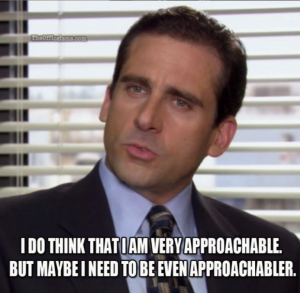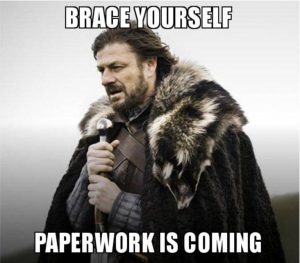Ever try reading the Bitcoin white paper? Feel like a dummy afterward? This post is for you! Blockchain doesn’t have to be confusing or intimidating. You also don’t need to understand technology. To prove it, let’s take this discussion to one of the most low-tech places there is: prison.
This prison has gangs—15 of them. None of the gangs trust each other, but all 15 gangs benefit from inter-gang trade. Since there’s no Venmo in prison, the gangs had to get a little creative, so they use ramen noodles as money. For just 500 packs, you can have your very own contraband iPhone!

Alf and Buddy’s trade gone wrong
Alf (a member of Gang A) presents 500 packs of ramen to Buddy (a member of Gang B). Buddy counts the ramen packs and gives Alf an iPhone.
All is well—except that the next day, Buddy claims Alf only paid 490 and demands 10 more packs of delicious noodles. Alf swears he paid full freight, but it’s not like he has an e-receipt to prove it. A fight breaks out. Two broken noses later, the gangs think, there must be a better way. We must have records!
An attempt at centralized records
Turns out that Gang C has a member who used to be an accountant in his glory days, before he got thrown behind bars for embezzlement. All the gangs agree he should be the bookkeeper of inter-gang trades. Secret handshakes ensue. This system works well—for a while, until a member of Gang D bribes the accountant into falsifying transactions. Didn’t see that coming.
Despite this turn of events, all the gangs still agree records are needed. But who should keep the records?
All 15 gangs.
A decentralized record-keeping system
Anytime there’s an inter-gang trade, fifteen bookkeepers (one for each gang) show up and record the transaction in their notebooks. If someone tries to make stuff up on the back end, it’s going to be obvious because the fake records won’t match the other 14 sets of records. In other words, if someone wants to falsify the records, they’re going to need to corrupt at least eight bookkeepers to do so.
These prisoners have unwittingly created a distributed ledger—the fundamental concept driving blockchain.
What is a distributed ledger?
A distributed ledger is, simply put, a decentralized system of record-keeping that takes trust out of the equation. Rather than having a central authority (such as a bank) validate and keep records of transactions, millions of computers have copies of the same transaction ledger. With centralized record-keeping, there is always a single point of failure; in contrast, it is incredibly difficult (if not nearly impossible) to defraud a well-designed distributed ledger.
You might think, I trust my bank. I don’t care if transactions are centralized. If that’s you, I leave you with these two thoughts:
- You might trust your bank not to purposefully do harm, but do you trust your bank to be 100% hack-proof?
- In today’s “cancel” culture, do you really want intermediaries to wield as much power as they do? You might trust your bank (or Amazon Web Services, or the Apple App Store, or Facebook) for now. But what happens when you publicly take a position they disagree with, and they cancel you? You may wonder, how the heck does this have anything to do with blockchain. In another post for another day, I’ll explain why blockchain and decentralization are so much bigger than Bitcoin. Prepare for your mind to be blown.




